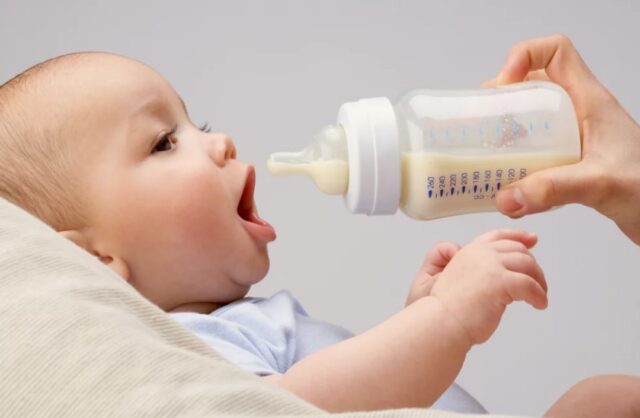
Pediatricians recommend breastfeeding babies at least for the first six months to ensure proper growth and development. There is no doubt that breast milk is the perfect food created by nature for the baby. Still, there are many circumstances where it is necessary to transfer the child to formula feeding, especially after the first year of life.
Nutrition should help your child to replenish energy, grow and develop. This requires regular changes to your baby’s menu depending on his or her age and nutrient requirements. The age from twelve to eighteen months is considered a transition period in nutrition.
The baby is no longer an infant, but it is not yet ready to completely switch to “adult” foods. So parents should find out what changes occur in a child’s diet after one year, what, when, and how often you should feed your child to provide a balanced diet.
What should be included in the baby’s diet?

Parents should take into account the peculiarities of the baby’s digestive system. At 12-18 months, it is more developed than in the first year of life. Enzyme systems are more active, which means that the child is ready to digest more complex products. However, the formation of organs such as the liver and pancreas is still in progress.
This is important to consider when selecting complementary foods and how they are prepared. Inadequate nutrition in babies after 12 months can lead to vitamin and mineral deficiencies, which in turn can lead to serious health problems such as iron deficiency anemia, osteoporosis, and dysbiosis.
Adult foods cannot give the baby all the vitamins and minerals he or she needs at this stage of development for further proper growth. Therefore, parents should pay more attention to baby food products when choosing the best option for toddlers, particularly baby formula.
Often parents of babies over 12 months old find it unreasonable to give baby formula, preferring to replace it with whole milk and milk products. Dairy products are still the central part of a baby’s diet even after 12 months because they are a great source of calcium, B vitamins, and a supplier of protein and milk fat.
And at the same time, milk can cause difficulty in digestion, trigger allergies, and lead to, most importantly, iron deficiency. Iron is a mineral vital to children for blood synthesis and metabolic processes, absorbed from milk only 10%. If a child is on mixed feeding or formula feeding, parents must take care of the optimal baby formula for his or her balanced diet at this age.
Making the switch to toddler formula

Milk formula for toddlers on organicsbestshop.com is marked as 3 stage (after 12 months) and 4 stage (after 18 months), unlike starter formula containing a higher protein content. Products for children in this age group include the entire range of vitamins and minerals following the recommended intake standards and higher mineral content.
The healthy gastrointestinal flora plays a significant role in protecting the body of the baby. Therefore, the baby’s diet would be better to contain prebiotic components, which promote the growth and predominance of beneficial flora in the intestines. For the formation and strengthening of bones, the baby needs calcium.
But in order for it to be effectively absorbed, the body needs a certain ratio of calcium, phosphorus, and vitamin D. Iron, zinc, and iodine enrichment helps prevent anemia and contributes to the full intellectual development of a growing baby. Baby formulas designed for toddlers contain all these components in the right proportion.
For babies on mixed or formula feeding, choosing a follow-on formula from the same brand is advisable. These formulas are usually similar in composition, and the transition to a new food can go almost imperceptibly for the baby.
There are no strict limits on how long a baby needs formula. Due to its natural and balanced composition, such a product will not be harmful to your baby. And on the contrary, it will positively impact at the age of over one year, as confirmed by many experts. The main thing is to take into account the baby’s individual nutritional needs and be sure to follow the pediatrician’s recommendations.
Tips for bottle feeding your baby

There are some tips recommended to follow for the sake of your baby’s health:
– Always give your baby water. It helps the formula to digest better. If your baby is constipated, the amount of water between feedings should be increased.
– Observe the eating habits. The optimal pause between meals is 3.5 hours during the day and 6 hours at night. The formula is digested longer than breast milk, and the baby can be fed a little less often.
– Do not force the baby to finish eating. If your little one refuses to eat after eating some of the formula, it means he or she is full. However, keep an eye on weight gain. If the child refuses to eat and loses weight, you should see the doctor and, after consultation, change the formula.
– Do not change the formula if it is suitable for the baby. Often changing the formula forces the baby’s body to go through an adaptation period again, which may negatively impact the baby’s well-being.
– Make sure that the baby does not overheat. Otherwise, it may cause problems with high blood pressure and high cholesterol in the future.
– Carefully watch the position of the bottle during feeding, so your baby does not swallow air.
– Follow the instructions when preparing the formula.
– Use only fresh formula. You should not give your baby leftover formula that has stood in the bottle for hours or more.
-If your baby has digestive issues (colic, constipation) or allergic reaction (rash, itching) to the new formula, be sure to contact your doctor.
That is why it is so important to carefully consider the choice of formula because frequent product substitution is not beneficial to the child. Still, it can cause digestive disorders – because getting used to a new formula takes time and effort for the baby’s body.








